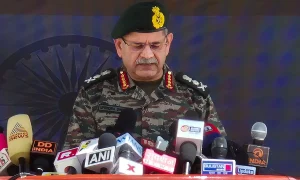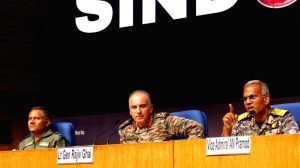New Delhi – Chief of Army Staff General Upendra Dwivedi has made a significant revelation about the Operation Sindoor Pakistan war, stating that the military conflict with Pakistan did not conclude with the cessation of hostilities announced on May 10. Speaking at the book launch of ‘Operation Sindoor: Before and Beyond’, General Dwivedi disclosed that the Operation Sindoor Pakistan war continued for an extended period due to numerous critical decisions that required implementation.
“You may be thinking the war finished on May 10. No. It continued for a long time because so many decisions had to be made. It will be difficult for me to share beyond that,” General Dwivedi stated, providing unprecedented insight into the complexity of the Operation Sindoor Pakistan war aftermath.
This revelation highlights the multifaceted nature of modern military conflicts, where official ceasefires may not immediately translate into complete resolution of hostilities.
Strategic Planning and Calibrated Response Framework

The Operation Sindoor Pakistan war demanded unprecedented strategic planning and careful calibration of military response. General Dwivedi emphasized that defense officials engaged in extensive discussions regarding the precise definition of a calibrated response, recognizing the absence of clear precedents for this particular conflict scenario.
“So, when to start, when to stop, how much to apply in terms of time, space, and resources, and what is the definition of calibrated, all these things are something which we kept on discussing at every point in time,” the Army Chief explained, detailing the complex decision-making process during the Operation Sindoor Pakistan war.
The strategic challenges of the Operation Sindoor Pakistan war required consultation with military veterans who presented multiple options for responding to the initial Pahalgam terror attack. This collaborative approach ensured that every action and deliberate non-action carried long-term strategic implications for India’s security posture.
Veteran Consultation and Strategic Options


During the critical phases of the Operation Sindoor Pakistan war, General Dwivedi personally consulted with numerous military veterans on April 22nd and 23rd to explore various response strategies. These experienced military leaders presented multiple “brilliant options” for addressing the complex security challenge posed by the Pahalgam terror attack.
The consultation process during the Operation Sindoor Pakistan war demonstrated the Indian military’s commitment to drawing upon institutional knowledge and experience when crafting responses to unprecedented security threats. This approach ensured that strategic decisions were informed by decades of military expertise and operational understanding.
The veteran input proved crucial in shaping the final approach adopted during the Operation Sindoor Pakistan war, contributing to what General Dwivedi later characterized as a “rhythmic wave” of military operations.
Indian Army’s Synchronized Military Response


General Dwivedi praised the Indian Army’s performance during the Operation Sindoor Pakistan war, describing their coordinated efforts as moving “like a rhythmic wave.” This metaphor captured the seamless integration of multiple military units and strategic elements throughout the 88-hour conflict period.
“The Indian Army during this complete thing moved like a rhythmic wave… In these 88 hours, you did not have the time to come for the planning, then pass the orders. Everybody was synergised and knew their orders,” the COAS emphasized, highlighting the exceptional preparedness demonstrated during the Operation Sindoor Pakistan war.
The synchronized response during the Operation Sindoor Pakistan war reflected years of training, preparation, and institutional coordination that enabled rapid deployment and execution of complex military operations without extensive real-time planning requirements.
Background and Triggering Events
The Operation Sindoor Pakistan war originated as India’s calibrated response to the devastating Pahalgam terror attack that occurred on April 22, claiming 26 innocent lives. This terrorist incident necessitated a strategic military response that would demonstrate India’s resolve while maintaining regional stability.
Also Read: Modi Skip UN Session: Stunning Decision Amid Trump 50% Tariff War
Operation Sindoor was officially launched on May 7, targeting nine specific terror locations in response to the Pahalgam attack. The Operation Sindoor Pakistan war represented a carefully calculated escalation designed to neutralize terrorist threats while avoiding broader regional conflict.
The terrorist attack that triggered the Operation Sindoor Pakistan war highlighted ongoing security challenges along the India-Pakistan border and the persistent threat posed by cross-border terrorism to civilian populations.
Pakistan’s Military Retaliation
Following India’s initial strikes, Pakistan responded with significant military escalation that expanded the scope of the Operation Sindoor Pakistan war. Pakistani forces launched drone and missile strikes targeting Indian positions, demonstrating their commitment to responding to Indian military actions with equal force.
However, Indian security forces successfully thwarted most of Pakistan’s retaliatory strikes during the Operation Sindoor Pakistan war, showcasing superior defensive capabilities and strategic preparedness. India then escalated its own response by targeting Pakistani airbases and radar systems, significantly expanding the conflict’s scope.
The Operation Sindoor Pakistan war witnessed severe cross-border shelling that continued for several days, creating a complex military situation requiring careful management to prevent further escalation into full-scale warfare.
Ceasefire Implementation and Aftermath
The official understanding regarding cessation of hostilities in the Operation Sindoor Pakistan war was announced on May 10, marking the formal end of active military engagements between the two nations. However, as General Dwivedi revealed, the strategic and operational aspects of the Operation Sindoor Pakistan war continued well beyond this date.
The extended nature of the Operation Sindoor Pakistan war aftermath demonstrates the complexity of modern military conflicts, where strategic implications and decision-making processes continue long after active hostilities cease.

